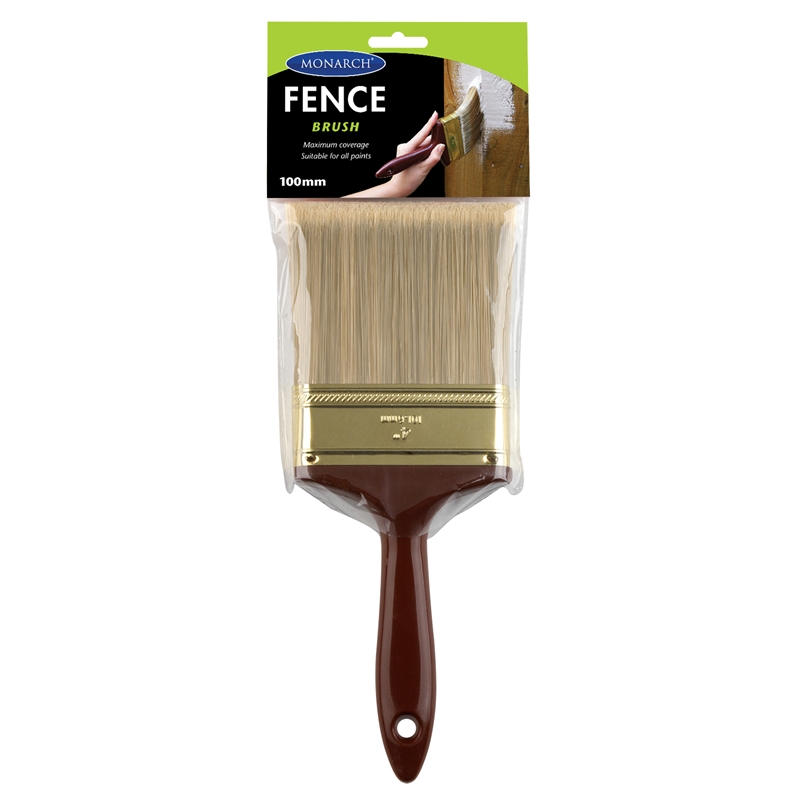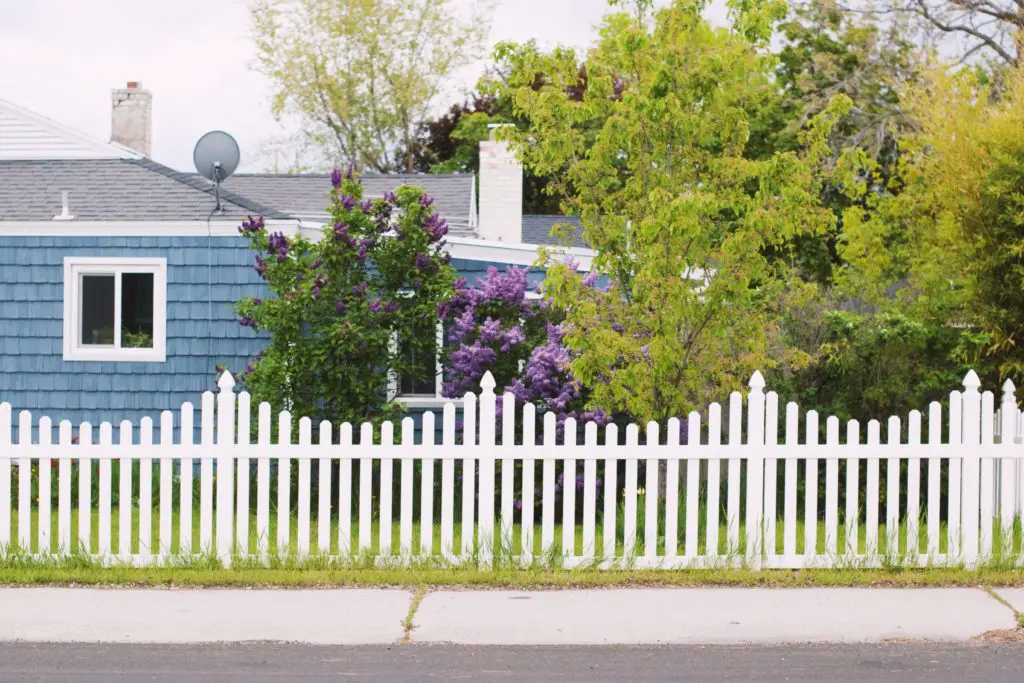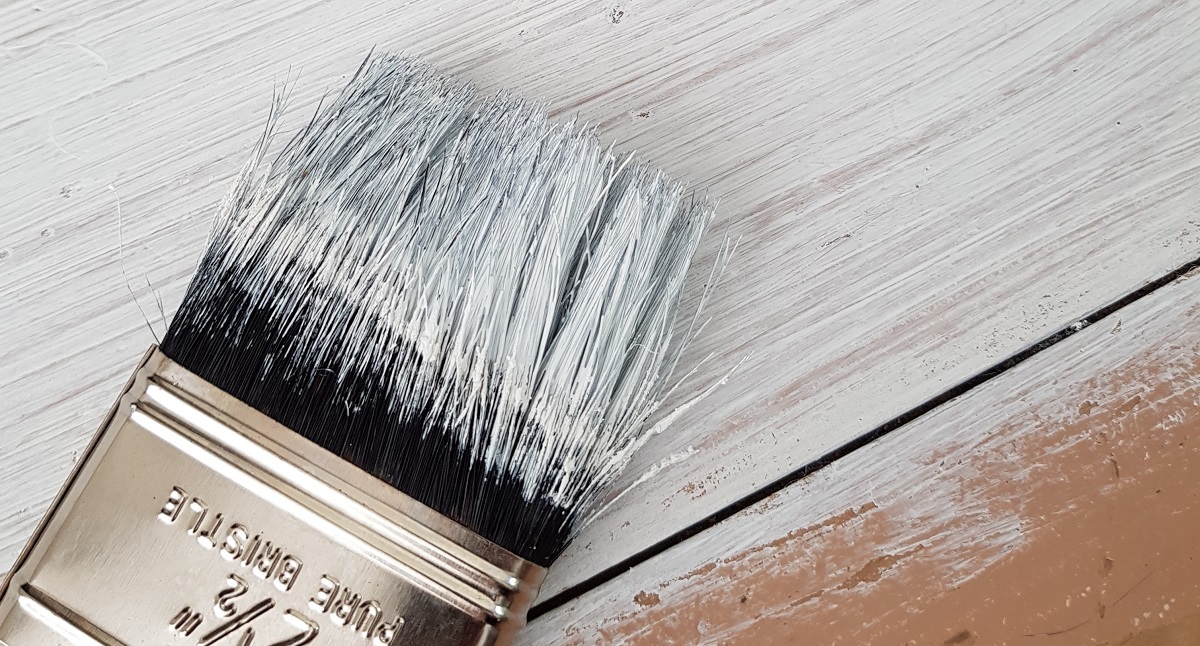Paint the antennae using your 0 round brush and mars black. Then to do the wings, use titanium white and your 4 round brush. Wipe a little excess paint off the brush so it is dry with not a lot of paint. When you paint the wings, start from the base and stroke out-words to make a dry brush stroke.
Paint the vertical pickets, working from the top of the fence to the bottom. If using a roller, back-brush every couple of feet to ensure even coverage and avoid lap marks. If you are using a paint sprayer, work in the same method, but stop every few feet and use a wide brush to back-brush. 2pc 4' shed fence & decking paint brush garden wall timber wood block paste wide.
Give a drab or dingy wooden fence a fresh face with a lustrous and long-lasting stained finish.
Photo: istockphoto.com
Whether your wooden fence is years old or newly installed, it can benefit from a single inexpensive addition: stain. Applying wood stain to the slats improves its design and prolongs the lifespan of your hard-working outdoor structure—a win-win!
For long-lasting, professional-quality results, work with a semitransparent oil-based stain designed for the exterior. These stains elegantly accentuate the natural patina of the underlying wood with a subtle tint, and, as a bonus, boast formulas that slow the growth of mildew and rot as well as protect the wood from ultraviolet light exposure.
With basic cleaning supplies and this straightforward tutorial on how to stain a fence, you can refresh your wooden privacy wall in as little time as a weekend—and reap these benefits right away.
How to Stain a Fence
STEP 1: Choose the right day (or days) for your project.
Before staining a wood fence, scan the weekly weather forecast and select a day with temperatures between 50 and 80 degrees, low to moderate humidity, and no precipitation expected for the next 24 hours. If you’re discouraged by the prospects, remember that “good things come to those who wait”. Extreme cold or moisture can prolong the drying time of wood stain, while the opposite extreme can dry out stain too quickly and leave behind unwanted lap marks on the fence.
STEP 2: Prepare the wood for painting.
Depending on the current condition of your fence, you may need to strip or sand the surface.
Starting with a previously stained or finished fence?
Apply wood stain or finish stripper to the slats according to the manufacturer’s instructions, then scrub the slats with a stiff-bristle brush to loosen the old varnish and slough off upright wood fibers.
Learning how to stain a fence that is new?
Ensure the stain will penetrate the wood with the water test: Lightly spray a small section of the fence with a garden hose. If water beads form on the slats, lightly sand the slats in the direction of the wood grain. Water successfully penetrating the slats, though, indicates that your wooden fence can readily absorb the stain.
STEP 3: Clean the fence thoroughly and let dry.
Clean the fence with water from a high-pressure spray nozzle attached to a garden hose (or use a power washer). This will remove light to moderate dirt accumulations and complete the job of the wood stain stripper in blasting away any old varnish from the fence, if applicable. If using a power washer, opt for a low-powered unit operating at no more than 2,000 psi so as not to weather the wood slats. Make sure to let the wood dry out completely before continuing.
STEP 4: Spot-treat mold or mildew with diluted bleach.

If you spot mold or mildew deposits on the fence, prepare a solution of bleach diluted with water in a bucket. Donning rubber gloves, apply the bleach to the slats with a garden sprayer, allowing it to settle into the slats for a few minutes before rinsing the fence clean with a high-pressure spray nozzle or power washer. Again, make sure to let the wood dry out completely before continuing.
STEP 5: Use wood filler to patch imperfections in the fence slats.
Repair chips, gouges, or cracks in the fence with wood filler. If needed, replace damaged slats.
Photo: istockphoto.com
STEP 7: Protect nearby plants and parts of the fence not to be stained.
Use painter’s tape to protect areas of the fence you do not want to stain. Similarly, protect surrounding vegetation at the foot of the fence by covering it with drop cloths.
STEP 8: Proceed to applying stain to the fence slats.
Enlist a brush, roller, or sprayer to stain the slats.
- A natural-bristle brush is the best way to encourage oil-based
wood stain to permeate wooden fence slats. Dip the tip of the brush into a can of stain, then coat any horizontal slats of the fence from left to right. Afterwards, work your way from top to bottom down the entire length of each vertical slat, maintaining a wet tip at all times. Stain one to two slats at a time to prevent lap marks from forming. One you reach the bottom of a slat, stain the end grain. - If using a roller, opt for a medium nap roller cover, then fully saturate the nap with the stain. Apply the stain in two- to three-foot sections of the fence at a time, taking care to back-brush, or re-paint over uncovered areas left by the previous stroke, with a wide brush. This will allow the stain to enter hard-to- reach grooves and recesses, and ensure an even coat free of lap marks.
- If using a sprayer, follow the same approach as for how to stain a fence with a roller, but stand back a comfortable distance from the fence to apply color.
STEP 9: Let the stain dry, then apply additional coats as desired.
When the entire fence has been stained, let it dry according to the stain manufacturer’s instructions. Apply additional coats of stain as needed to achieve the desired depth of color. A single coat should be sufficient for a new wood fence or one that you also plan to seal.
STEP 10: Finish the job with a coat of sealer.
While a good quality stain alone is sufficient to protect your fence from everyday wear-and-tear, applying a durable sealant over the stain can prolong the finish—and the life of your fence. For best results, apply a single coat of clear, weatherproof sealant by brush, roller, or sprayer. Quickly back-brush unsealed grooves and recesses with a wide brush to achieve a uniform appearance. Allow the sealant to dry completely.
STEP 11: Clean up!
Dispose of soiled drop cloths, remove the painter’s tape from the slats, and reveal your like-new fence!
Go ahead and take the next couple of summers off—you earned it. Only note that while semitransparent stains can last anywhere between two to five years, extreme temperatures and precipitation can prematurely age the finish. Don’t rest on your laurels too long and risk the weather damage: Aim to stain your fence every two to three years to preserve its sheen and weather protective qualities.
Good quality garden fence paint protects your wooden fence from rotting, warping, cracking and fading. Even if built your fence with treated wood, adding a coat of outdoor-rated paint on top provides extra protection.
In this buying guide, I recommend the best garden fence paints in the UK, and give you some tips on how to choose the right one for your fence.
By the way, these paints are not just great for fences; most of them also work great on wooden sheds, outdoor furniture and decking.
What You'll Learn Today
- Key Considerations When Choosing Garden Fence Paint
- Best Garden Fence Paint: Top 5 Reviews
Key Considerations When Choosing Garden Fence Paint
A. UV and Moisture Protection
UV and water are the most damaging elements to a wooden fence, even the best one. UV will age, discolour and fade the wood, while water will cause warping and rotting.
Look for garden fence paint that provides UV protection. This ensures the fence retains its colour and finish for years.
The paint should also provide a waterproof or water resistant layer that protects the wood underneath from moisture damage.
B. Amount
Buy an amount of paint that will be just enough for your garden fence. Because you won’t need to reapply the paint for several years, there’s no point buying a lot of paint and have the leftover sitting in storage for years.
Garden fence paint comes in amounts ranging from small 1L cans to large 9 or 10 litre buckets. The ideal amount depends on the size of your fence and the coverage the paint provides.
C. Method of Application (Brush, Roller or Sprayer)
Most garden fence paints can be applied using a normal brush or a roller brush.
If you have a large fence to paint, I recommend looking for paint that can be put in a sprayer. Spraying the paint allows you to cover a large area in less time and with less effort.
D. Lifespan
How many years of protection does the paint offer? The longer, the better.
The minimum lifespan to go for is 3 years. Paint with a shorter lifespan will require frequent re-application, costing you more money in the long run.
Some premium garden fence paints have a longer lifespan of 5-10 years. These are ideal if you want to apply the paint once and forget about it for years.
Garden Fence Paint Brush Reviews
E. Coverage and No. of Coats
Check how many square metres a litre of paint or the entire can will cover. Wider coverage means a single can will cover a larger area. If you have a large fence to paint, a wide-coverage paint will save you money.
Also, check the number of coats you need to get full protection from the elements. Most garden fence paints today are single-coat, which saves you money.
However, if your fence is in bad shape, you may need two coats to fully restore it.
F. Colour and Finish
Garden fence paints come in a variety of colours and finishes with names like harvest gold, botanical retreat and forest green. The best choice comes down to your preferences and the state of the fence.
If you like how your fence looks and you just want to add a layer of water and UV protection, look for clear paint, though that’s hard to find. Most clear paints are actually preservers or stains.
If you are looking to refresh your fence while adding a protective coat, choose whichever colour you love.
Also, check whether the paint has a glossy or matte finish.
G. Safe for Plants
If you have a kitchen or flower garden near the fence, look for a non-toxic paint that’s safe for plants. Most plant-safe paints are water-based.
A plant-safe paint is also the best choice for use on garden gates, railings and fences.
Best Garden Fence Paint: Top 5 Reviews
1. Johnstones Woodcare One Coat Shed & Fence Paint, 9L
If you have a large fence, I recommend this 9L bucket of shed and fence paint. It’s available in forest green, dark oak, red cedar and golden chestnut.
The Johnstonespaint provides colour, moisture and UV protection to outdoor wooden surfaces including fences, railing and sheds.
The protection lasts about three years. But if you live in a place with extreme weather, you may need to apply a new coat sooner.
As the name suggests, a single coat is enough to protect your fence from water and UV. But some customers preferred the smoother look of a second coat. Two coats also provide extra protection in extreme climates.
If you decide to apply two coats, two hours of drying time between the coats is adequate.
The best way to apply it is using a brush or roller. You can spray it, but you may need to thin it down. In that case, you’ll need to apply at least two coats.
What I like about it:

- Multiple colour options.
- 3-year moisture and UV protection.
- Large bucket – ideal for large fences or a shed.
- Single coat application.
2. Cuprinol Garden Shades, 2.5L
If you are looking for a smaller can of fence paint, get the 2.5L Cuprinol Garden Shades paint. It’s available in a wide variety of colours including willow, pale jasmine, seagrass and seasoned oak.
The paint is not just good for wooden surfaces. It can also be applied on brick, stone and terracotta.
Most customers found two coats to be perfect for a beautiful finish. That’s enough to protect the surface from fading, discolouration, pests and rot for up to 6 years.
The Cuprinol paint is water-based, making it a safe choice for fences that are near plants. It’s also safe for pets.
Application is easy. You can use a bristle brush, a roller brush or put the paint in a sprayer. The sprayer option is great for covering a large area quickly.
Best Paint Brush
What I like about it:
- Safe for plants and pets.
- Long lasting protection from moisture and UV – 6 years.
- Multiple way to apply it – brush, roller or spray.
- Available in many colours.
3. Johnstone’s 309286 Garden Colours, 2.5L
The Johnstone’s Garden Colours paint is another good choice if you are looking for a plant-safe paint. Once it dries, it’s harmless to plant and pets.
What I love most about the Johnstone’s Garden Colours is how versatile it is. It is suitable for just about anything in your garden, not just the fence. This includes furniture, sheds, railing, decks and storage boxes.
In most cases, a single coat is enough, though applying two coats won’t hurt. A 2-4 hour drying time between applications is adequate.
The best way to apply it is using a brush. The manufacturer doesn’t say anything about putting it in a sprayer, but several customers used a sprayer with great results.
A single application lasts 3-4 years, after when you can apply a fresh coat on top.
What I like about it:
- Available in over a dozen colours.
- 3-4 year lifespan.
- Single coat application.
- Suitable for different kinds of outdoor wooden surfaces.

4. Ronseal One Coat Quick Dry Garden Shed & Fence Paint, 5L

If you are shopping on a budget, I recommend the Ronseal One Coat fence and shed paint. It costs less than the 2.5L cans above, though it has a shorter lifespan.
This 5-litre bucket of Ronseal quick dry fence paint is ideal for 30 square metres of fence. Each litre covers about 6 square metres.
For a standard 2m high fence, this bucket should be enough for 15m of fence length.
You only need one coat to get a beautiful smooth finish with a lifespan of about two years. The paint’s consistency is light enough that you can apply using a brush or sprayer.
There are half a dozen colours to choose from including red cedar, harvest gold and forest green.
What I like about it:
- Dries quickly – 1 to 2 hours.
- Wide coverage.
- Low price for a 5L bucket.
- One coat application.
5. Roxil Wood Protection Cream, 1L
This one’s a bit pricey, but that’s because it’s not really a paint. Instead, it’s a wood protection cream that provides 100% waterproof protection. It is the best choice if you want to weatherproof your garden fence and other surfaces such as garden furniture and decking.
The white cream easily spreads on a wood surface using a brush or roller. A single coat provides 10 years of weather protection.
For best results, I recommend scrubbing or power washing the fence (or whichever surface you are applying the cream on) to get rid of dirt, mould and mildew. A clean surface absorbs the cream much better.
Note that the cream doesn’t change the colour of surfaces. It can reduce a greyed appearance and give your fence and furniture a beautiful sheen, but the natural character and colour of the wood still comes through.
Again, the Roxil wood protection cream is expensive, even more so if you plan to use it on the fence. You’ll probably need several of the 1-litre cans. A single can is good for 4-5 square meters.
But considering the level of weather protection it offers and its 10-year lifespan, I think it’s worth it. Your furniture, fence or deck will look better and last longer.
What I like about it:
- Excellent weather protection.
- 10-year lifespan.
- Easy to apply.
